
EVN/JIVE Newsletter - Edition 63 September 2022
Welcome to the September 2022 issue of the EVN/JIVE Newsletter.
A lot has happened since May. Most important we have finally been able to attend meetings in person and share the lively and collaborative spirit our VLBI community has always shared. The 15th EVN Symposium in Cork and the VLBI Special session at the IAU GA in Busan are important landmarks for a return to normality.
The selection of the science highlights clearly shows the innovative potentials of the EVN, as well as the broadness of VLBI, extending to hundreds of GHz in frequency all the way to EHT. The investment of EVN and JIVE to ensure users' support and broaden the VLBI users' community is continuing not only with the European Radio Interferometry School (ERIS 2022), but also with the new pilot programme which provides extra support to new users.
The list of forthcoming events deserves special attention, and clearly shows the VLBI community is moving forward, with new prospects for developments and new scientific challenges.
All this and much more is reported in this issue. Enjoy the reading.
We wish to thank our lively and enthusiastic community for the many results shared at meetings during the summer. These are the logs we need to keep the VLBI fire burning and expanding.

EVN Consortium Board
of Directors Chair

JIVE Director

Observing proposals are invited for the European VLBI Network (EVN). Deadline: 1 October 2022, 16:00:00 UTC. The EVN facility is open to all astronomers. Astronomers with limited or no VLBI experience are particularly encouraged to apply for observing time. Student proposals are judged favorably. Support with proposal preparation, scheduling, correlation, data reduction and analysis can be requested from the Joint Institute for VLBI ERIC (JIVE). Check details of the call for proposals here.
EVN Support+ programme
JIVE/EVN has a pilot programme to provide extended support to teams new to the EVN, with little or no direct VLBI experience. This includes the scheduling of the VLBI run and the VLBI-specific parts of the data reduction (including a-priori amplitude calibration and fringe-fitting). Imaging, and the interpretation of the data is the responsibility of the team. We aim to support some standard VLBI projects, evaluated by the EVN Program Committee with the highest grades. See the call for proposals for more information. For further questions please contact the Chair of the EVN PC, Zsolt Paragi (evnpc@jive.eu).

Potential magnetic pole inversion in a changing look Active Galactic Nuclei
Sibasish Laha (NASA Goddard Space Flight Center, USA) on behalf of co-authors of the paper
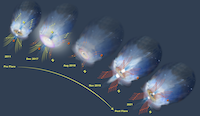
Recent discoveries of so-called changing-look AGN (CL-AGN), have given us a rare view of extreme changes in the AGN state spanning a few months to years, which may give insight into major open questions about the nature of AGN fueling. CL-AGN are rare, with only a few dozen candidates in the literature. One of the most dramatic cases is 1ES 1927+654, a nearby (74.2 Mpc) and previously well-studied type 2 AGN which was observed to undergo a dramatic optical outburst beginning in December 2017. In this work (Laha et al., 2022) we report the evolution of the radio, optical, UV and X-rays from the pre-flare state... Read More
Radio-loud Quasars above Redshift 4: VLBI Imaging of an Extended Sample
Máté Krezinger (ELTE, Hungary), Krisztina Perger (CSFK, Hungary), Krisztina É. Gabányi (ELTE, Hungary), Sándor Frey (CSFK, Hungary), Leonid I. Gurvits (JIVE, the Netherlands), Zsolt Paragi (JIVE, the Netherlands), Tao An (SHAO, China), Yingkang Zhang (SHAO, China), Hongmin Cao (SHNU, China), Tullia Sbarrato (INAF, Italy)

Quasars in the early Universe (z < 4) provide excellent tools to study the evolution of galaxies and supermassive black holes. These high-redshift sources are tracers of processes from early-time star forming activity to primordial active galactic nuclei (AGN). The latter are powered by accretion onto supermassive black holes (SMBH) with masses of up to 1010 𝑀⊙ (Sbarrato, 2021). In recent years, a couple of high-redshift jetted sources were revealed by various radio sky surveys. Because only about... Read More
Radio properties of the OH megamaser galaxy IIZw 096
Wu Hong (Guizhou Univeristy), Wu Zhongzu(Guizhou University), Sotnikova Yu (SAO, Russia), Chen Yongjun (SHAO China), Zhang Bo (SHAO China), Mufakharov T(SAO, Russia), Shen Zhiqiang (SHAO, China), Chen Xi (Guangzhou University, China), Mikhailov A (SAO Russia), Mingaliev M (SAO Russia), Han Xianming L, Misra Prabhakar
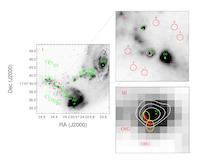
IIZw 096 is classified as a LIRG (Inami et al. 2010), and is one of the most luminous OHM galaxies known (Bottinelli et al. 1986). This particular source is the second system to host formal megamasers involving both OH and H2O species (Wagner 2013; Wiggins et al. 2016). Optically, IIZw 096 shows complex morphology (Inami et al. 2010). It contains four main regions, denoted A, B, C, and D (see Figure 1); sources A and B are possibly two spiral galaxies. Near-IR imaging and spectroscopic observations show that source D is a powerful starburst not associated with the primary nuclei (sources A and B), which could be a starburst in the disturbed disk of source A, or even the nucleus of a third galaxy (Goldader et al. 1997; Inami et al. 2010). We analysed two-epoch EVN archival data of the OH 1667MHz line emission of IIZw 096 and confirmed that this source’s OH 1667MHz line emission is mainly from two regions. We found no significant variations of the OH 1667MHz line emission from the two areas, including... Read More
Multiwavelength View of the Close-by GRB190829A Sheds Light on Gamma-Ray Burst Physics
Om Sharan Salafia (INAF – Osservatorio Astronomico di Brera and INFN, Italy)
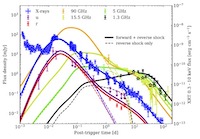
Gamma-ray bursts have been serendipitously discovered in the late 1960’s (see Klebesadel et al. 1973 and Weekes 1999 about the initial discovery, and Kumar and Zhang 2015 for a recent review), but our understanding of the underlying physical processes is still far from complete. We have solid evidence that the main ingredient is a relativistic jet, that is, a narrow surge of plasma that travels almost at the speed of light. The short duration (seconds to minutes, rarely hours) and extremely large energy of these jets points to the central ‘engine’ (the place where these jets are born) being a black hole or a neutron star. Indeed, some supernovae have been identified (the first being SN1998bw, see Galama et al. 1998) in association to gamma-ray bursts, which clearly indicates that these formed following the core-collapse of a massive star – which is known to lead to the formation of a black hole... Read More
SgrA* revealed
Ilse van Bemmel (JIVE, the Netherlands) and Huib van Langevelde (JIVE, the Netherlands)
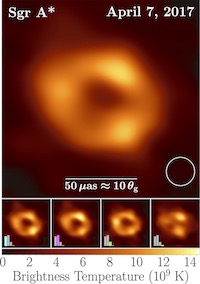
The Event Horizon Telescope Collaboration (EHTC) made global front page news with the first images of the M87 supermassive black hole in 2019. To image our Galactic black hole, Sagittarius A* (SgrA*), turned out to be a much bigger challenge. At last, on Thursday 12 May 2022 the EHTC presented the first image of SgrA* to peers and the public. This happened at different venues around the globe, with ESO headquarters in Garching, Germany, covering the news for Europe. The data for this image were obtained in the same observing run in 2017, but included a set of new and unique challenges to overcome. The much smaller intrinsic size of SgrA* causes it to vary on much shorter times than the typical length of a VLBI observing track. It was compared to taking a picture of a dog chasing its tail in a dark room. Consequently, it took several years for the EHTC to develop robust techniques for imaging and image validation. Eventually, an entire family of images was produced which is compatible with the data, and 97% of these images are consistent with a ring-like structure with a diameter of ~51 micro-arcseconds. The image shown to the press and public is a weighted average across this family (see Figure 1). Although the SgrA* image is second to the M87*, imaging our Galaxy’s black hole probably represents a more fundamental result, because mass and distance are so much more accurately determined as stars in orbit around it have been measured with great accuracy. The general public showed a keen interest in the result. The results were covered by many media and EHTC astronomers... Read More

JIVE 2021 Annual Report and EVN 2019-2020 Biennial Report published
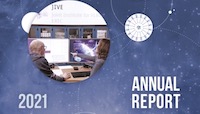
The JIVE Annual Report 2021 presents a summary of JIVE’s many activities throughout the year.
The EVN Biennial 2019-2020 Report comprises information on the EVN science, operations, observatory reports, activities, meetings and publications.
A Successful 15th EVN Symposium
Denise Gabuzda (University College Cork, Ireland)
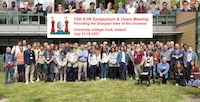
The 15th EVN Symposium was originally scheduled for 2020. After cancelling this event in 2020 and holding an online “mini-symposium” in 2021, the full 15th European VLBI Network Symposium was finally held as a “blended” or “hybrid” meeting on 11-15 July 2022. Seventy-one in-person participants at University College Cork, Ireland, were joined by 42 participants online. The setup ensured that online participants could hear all speakers clearly, and that online presentations were visible on a large screen and were clearly audible. Both in-person and online participants could ask questions; the main limitation of the technical... Read More
The First EVN Users’ Training Event
Benito Marcote (JIVE, the Netherlands) on behalf of the EVN User Support Group
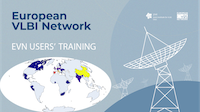
On 11 May 2022, JIVE organised the first online EVN Users' Training Event with the aim to support first-time users of the European VLBI Network (EVN). The EVN Support Scientists guided participants through the different steps to allow them to prepare and submit an observing proposal as well as the scheduling of observations.A total of 61 participants from 20 different countries registered to attend this training event from completely different backgrounds, mostly outside the VLBI radio community. We hope this kind of training will boost connections and collaborations between groups from different fields... Read More
The EVN Archive officially part of the Virtual Observatory
Mark Kettenis (JIVE, the Netherlands)
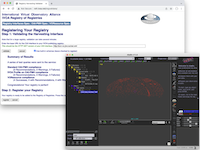
Thanks to the EC funded ESCAPE project, JIVE is now running its own Virtual Observatory (VO) service that provides access to all the public data in the European VLBI Network (EVN) archive hosted by JIVE.This VO service provides a searchable catalogue of all EVN observations that were correlated at JIVE (and a few correlated at the other EVN correlator at MPIfR in Bonn, Germany). The catalogue is made available through the International Virtual Observatory Alliance's (IVOA) standard Table Access Protocol (TAP) and provides search results describing the observations following the standardised IVOA ObsCore schema. The service can be accessed at http://evn-vo.jive.eu/tap but since we now also publish the service to the VO registry it can be easily found in applications such as Aladin and TOPCAT, or the PyVO Python module... Read More

It is time to join the Science Forum of the Global VLBI Alliance (GVAS), a Working Group in IAU Commission B4!
Francisco Colomer (JIVE, the Netherlands)
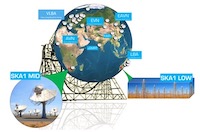
The Global VLBI Alliance (GVA) has established a Science Forum (GVAS) in order to promote VLBI widely. The GVAS was presented at the recent IAU B4 business meeting on 8 August 2022. The session presented the current and future plans for the main cm-VLBI networks (EVN, EAVN, VLBA, LBA), as well as the VLBI connection with SKA (SKA-VLBI). In the short discussion that followed, some topics are identified as core actions for the GVAS...Read More
CRAF Update – The battle for the 6 GHz band
Benjamin Winkel (CRAF Chair, Max-Planck-Institut für Radioastronomie, Germany) and Waleed Madkour (CRAF Frequency Manager, JIVE, the Netherlands)
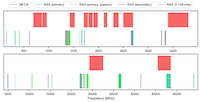
The Committee on Radio Astronomy Frequencies (CRAF) is an Expert Committee of the European Science Foundation. It aims to provide a cost-effective single voice on frequency protection issues for European radio astronomy observatories and research institutes, achieving a significantly greater impact than that achievable by individual national institutions. By working together European observatories and institutes can profit from synergy effects by covering many more topics and learning from each other. CRAF was founded in 1988 and has since then been engaged with the International Telecommunication Union...Read More
Summer in Dwingeloo
Claire Cook (JIVE/ASTRON Summer Student 2022)
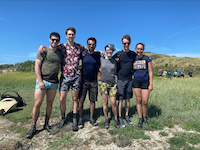
My name is Claire Cook, I'm in my fourth year of completing my Bachelor of Science in Astronomy from the University of Kansas in the U.S., and this summer I had the chance to work as a summer student with Suma Murthy, Rafaella Morganti, and Zsolt Paragi using VLBI to study the effects of Active Galactic Nuclei (AGN) on galaxy evolution. Working here at JIVE has been a unique and exciting opportunity. This summer project presented a myriad of new experiences for me—living abroad, working with VLBI, and engaging with such an internationally-collaborative organisation like JIVE. Out of all the internships for which I applied this summer, this one was my top choice for a reason and I’m more than grateful to be here. The JIVE community is a fun one and I’ve had a blast working with everyone here this summer. There was something about sitting at my desk in the JIVE corridor...Read More
News from ORP
ORP Executive Management Team
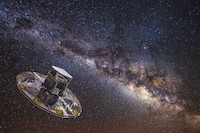
OPTICON RadioNet Pilot (ORP) is one of the European Commission's transnational access 'pilot' programs under EC H2020, launched in March 2021. This four-year project brings together 37 institutions to support and develop seamless access to radio and optical facilities. Several members of the ORP community took the opportunity to meet at the EAS 2022 in Valencia, Spain, during the special session "European Forum of Astronomical Communities'' held on 30 June 2022. The session was chaired by prof. Lukasz Wyrzykowski (UNIWARSAW) and aimed to discuss the development of underrepresented astronomy communities in Europe and to present the current opportunities for researchers within Europe. The ORP communities were ... Read More

- 2nd Malaysian VLBI Workshop, Kuala Lumpur, Malaysia | 5-8 September 2022
- VLA Sky Survey in the Multiwavelength Spotlight, Socorro, USA | 7-9 September 2022
- European Radio Interferometry School (ERIS 2022), Dwingeloo, The Netherlands - 19-23 September 2022
- ALMA Archive School 2022, Bologna, Italy | 5-7 October 2022
- Next Generation Space VLBI (ngSVLBI) Workshop, Dwingeloo, The Netherlands - 17-19 October 2022
- International Conference on Research Infrastructures (ICRI) 2022, Brno, Czech Republic - 19-21 October 2022
- 11th IRAM Interferometry School, Grenoble, France | 21-25 November 2022
- IAU Symposium (IAUS) 380 Cosmic Masers: Proper Motion toward the Next-Generation Large Projects, Kagoshima City, Japan & hybrid | 20-24 March 2023
- New Eyes on the Universe: SKA & ngVLA Conference, Vancouver, Canada | 30 April - 5 May 2023
- Bologna-VLBI: Life begins at 40! New frontiers and scientific challenges with enhanced frequency/time/space dynamic range, Bologna, Italy | 22-26 May 2023
EVN/JIVE Newsletter Editorial Team: Francisco Colomer (JIVE Director), Jorge Rivero González (JIVE Science Communications Officer), Zsolt Paragi (JIVE Head of User Support) and Aukelien van den Poll (JIVE Finance and Project Officer).
Newsletter edited by Jorge Rivero González (JIVE). For any enquiries about the newsletter, please contact Jorge Rivero González at communications@jive.eu.